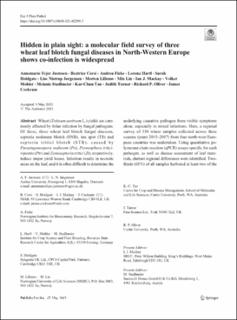| dc.contributor.author | Justesen, Annemarie Fejer | |
| dc.contributor.author | Corsi, Beatrice | |
| dc.contributor.author | Ficke, Andrea | |
| dc.contributor.author | Hartl, Lorenz | |
| dc.contributor.author | Holdgate, Sarah | |
| dc.contributor.author | Jørgensen, Lise Nistrup | |
| dc.contributor.author | Lillemo, Morten | |
| dc.contributor.author | Lin, Min | |
| dc.contributor.author | Mackay, Ian J. | |
| dc.contributor.author | Mohler, Volker | |
| dc.contributor.author | Stadlmeier, Melanie | |
| dc.contributor.author | Tan, Kar-Chun | |
| dc.contributor.author | Turner, Judith | |
| dc.contributor.author | Oliver, Richard P. | |
| dc.contributor.author | Cockram, James | |
| dc.date.accessioned | 2021-07-19T12:24:08Z | |
| dc.date.available | 2021-07-19T12:24:08Z | |
| dc.date.created | 2021-06-28T15:48:57Z | |
| dc.date.issued | 2021-05-25 | |
| dc.identifier.citation | European journal of plant pathology. 2021, . | en_US |
| dc.identifier.issn | 0929-1873 | |
| dc.identifier.uri | https://hdl.handle.net/11250/2764778 | |
| dc.description.abstract | Wheat (Triticum aestivum L.) yields are commonly affected by foliar infection by fungal pathogens. Of these, three wheat leaf blotch fungal diseases, septoria nodorum blotch (SNB), tan spot (TS) and septoria tritici blotch (STB), caused by Parastagonospora nodorum (Pn), Pyrenophora tritici-repentis (Ptr) and Zymoseptoria tritici (Zt), respectively, induce major yield losses. Infection results in necrotic areas on the leaf, and it is often difficult to determine the underlying causative pathogen from visible symptoms alone, especially in mixed infections. Here, a regional survey of 330 wheat samples collected across three seasons (years 2015–2017) from four north-west European countries was undertaken. Using quantitative polymerase chain reaction (qPCR) assays specific for each pathogen, as well as disease assessment of leaf materials, distinct regional differences were identified. Two-thirds (65%) of all samples harbored at least two of the three pathogens. Norway had high SNB abundance, but also showed mixed infections of SNB, TS and STB. In Germany, TS was prevalent, with STB also common. Danish samples commonly possessed all three pathogens, with STB prevalent, followed by TS and SNB. The UK had a major prevalence of STB with minimal occurrence of TS and SNB. Across all samples, qPCR identified Zt, Pn and Ptr in 90%, 54% and 57% of samples, respectively. For each pathogen, average disease levels via visual assessment showed modest positive correlation with fungal DNA concentrations (R2 = 0.13–0.32). Overall, our study highlights that the occurrence of mixed infection is common and widespread, with important implications for wheat disease management and breeding strategies. | en_US |
| dc.language.iso | eng | en_US |
| dc.publisher | Springer | en_US |
| dc.rights | Navngivelse 4.0 Internasjonal | * |
| dc.rights.uri | http://creativecommons.org/licenses/by/4.0/deed.no | * |
| dc.title | Hidden in plain sight: a molecular field survey of three wheat leaf blotch fungal diseases in North-Western Europe shows co-infection is widespread | en_US |
| dc.type | Peer reviewed | en_US |
| dc.type | Journal article | en_US |
| dc.description.version | publishedVersion | en_US |
| dc.rights.holder | © The Author(s) 2021 | en_US |
| dc.source.pagenumber | 949–962 | en_US |
| dc.source.volume | 160 | en_US |
| dc.source.journal | European journal of plant pathology | en_US |
| dc.identifier.doi | 10.1007/s10658-021-02298-5 | |
| dc.identifier.cristin | 1919042 | |
| dc.relation.project | Andre: Danish Council of Strategic Research 5147-00002B | en_US |
| dc.relation.project | Andre: BBSRC BB/N00518X/1 | en_US |
| dc.relation.project | Norges forskningsråd: 251894 | en_US |
| dc.relation.project | Andre: Deutsche Forschungsgemeinschaft HA 5798/2-1 & 619206 | en_US |
| dc.relation.project | EU/COST Action “SUSTAIN” | en_US |
| cristin.ispublished | true | |
| cristin.fulltext | original | |
| cristin.qualitycode | 1 | |

